DMZ and Panmunjeon Tour
Wednesday, February 16th, 2011 in: News, Travel
North and South Korea are separated by a 4km strip of land called the De-Militarized Zone (DMZ), stretching across the entire peninsula at the 38th parallel, unmoved in the nearly 60 years since the armistice was signed in 1953. I didn’t know much about the history of relations between the north and south when I walked up to the USO tour office at 6am Saturday morning.
The only way to get to the DMZ is on a tour, and the only tour that takes you all the way up to the Military Demarcation Line (MDL) is run by USO. It’s more expensive, but it’s worth it. In addition to the Dorasan Observatory and train station and 3rd Infiltration Tunnel, the USO tour takes you into the DMZ itself, around Camp Bonifas and into Panmunjeon, around the table where the only communication between north and south takes place.
 As the bus trundled through the city, our guide, Sunny pointed out various points of interest. I looked up into office buildings, already lit up and inhabited by office workers. Sunny pointed out the wire entanglement lining 150 miles of river, meant to prevent infiltration by NK operatives since their failed attempt to assasinate President Park in 1968. I looked over empty guardtowers, standing vigiliant over the the grey misery of the northern Han, cloaked in ice and dimly lit by the overcast morning, slowly brightening to hint that somewhere beyond the haze the sun was trying to warm the barren landscape. Sunny explained the mandatory military service, perhaps the only way they could populate the guardtowers. A light snow began to fall, dropping visibility to just a few hundred meters; Dorasan Observatory would be a bust. The windows fogged up from idle conversation and snoring, obscuring what view was left. We passed the Freedom Bridge, where 12,000 POWs crossed from north to south when the war “ended.”
As the bus trundled through the city, our guide, Sunny pointed out various points of interest. I looked up into office buildings, already lit up and inhabited by office workers. Sunny pointed out the wire entanglement lining 150 miles of river, meant to prevent infiltration by NK operatives since their failed attempt to assasinate President Park in 1968. I looked over empty guardtowers, standing vigiliant over the the grey misery of the northern Han, cloaked in ice and dimly lit by the overcast morning, slowly brightening to hint that somewhere beyond the haze the sun was trying to warm the barren landscape. Sunny explained the mandatory military service, perhaps the only way they could populate the guardtowers. A light snow began to fall, dropping visibility to just a few hundred meters; Dorasan Observatory would be a bust. The windows fogged up from idle conversation and snoring, obscuring what view was left. We passed the Freedom Bridge, where 12,000 POWs crossed from north to south when the war “ended.”
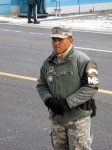 Corporal Casiano jumped aboard and checked our IDs, taking over the tour from Sunny for the DMZ portion. He spoke rapidly, explaining the rules. All I caught was “no photos until I give the go-ahead.” He looked like a latin Lawrence Fishburn, with his strong jaw, gapped teeth, and friendly but no-nonsense demeanor, punctuated by the pistol at his hip. He took us to Ballinger Hall, where we got briefed on the rules, and the consequence of not following them. “Don’t worry, you won’t get hurt,” he smiled wide and handed out declarations, releasing the UN of any liability in case Corporal Casiano isn’t quick enough with that pistol of his.
Corporal Casiano jumped aboard and checked our IDs, taking over the tour from Sunny for the DMZ portion. He spoke rapidly, explaining the rules. All I caught was “no photos until I give the go-ahead.” He looked like a latin Lawrence Fishburn, with his strong jaw, gapped teeth, and friendly but no-nonsense demeanor, punctuated by the pistol at his hip. He took us to Ballinger Hall, where we got briefed on the rules, and the consequence of not following them. “Don’t worry, you won’t get hurt,” he smiled wide and handed out declarations, releasing the UN of any liability in case Corporal Casiano isn’t quick enough with that pistol of his.
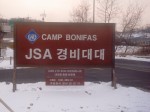 We crossed through the three barriers bordering the DMZ: a 15 foot tall tank wall, 200 yards of heavily mined forest, and a 20ft electrified fence. We entered the DMZ and started passing rice fields farmed by the locals. Both North and South Korea are allowed to operate just one village within the DMZ; the South has Taesongdong (Freedom Village), and 4km away is Gijungdong, known as propaganda village. Due to this strict regulation, the DMZ is one of the most pristine wildernesses left in the world. Residents of Taesongdong are exempt from taxes and have certain autonomy, as well as free college education at any university they can get accepted to. In exchange, they must spend 240 days out of the year in Taesongdong, where they have a strict curfew, and are living and working between two nations still technically at war. There was one story of a woman working in the rice fields, who was almost kidnapped by NK soldiers. They claimed she was trying to defect, since they’re such an asshole.
We crossed through the three barriers bordering the DMZ: a 15 foot tall tank wall, 200 yards of heavily mined forest, and a 20ft electrified fence. We entered the DMZ and started passing rice fields farmed by the locals. Both North and South Korea are allowed to operate just one village within the DMZ; the South has Taesongdong (Freedom Village), and 4km away is Gijungdong, known as propaganda village. Due to this strict regulation, the DMZ is one of the most pristine wildernesses left in the world. Residents of Taesongdong are exempt from taxes and have certain autonomy, as well as free college education at any university they can get accepted to. In exchange, they must spend 240 days out of the year in Taesongdong, where they have a strict curfew, and are living and working between two nations still technically at war. There was one story of a woman working in the rice fields, who was almost kidnapped by NK soldiers. They claimed she was trying to defect, since they’re such an asshole.
The Freedom House was constructed on the South side of the MDL, intended to be a venue for reunions between family members from both sides. Since North Korea doesn’t let its citizens leave the country, the Freedom House has never been used. From the back of the Freedom House, there’s a row of small bungalows straddling a concrete line: the MDL. South Korean Soldiers stood at ROK Ready (wide stance, fists clenched at the sides, face unflinching behind classic aviators), their bodies only half-exposed to minimize a target in case of a firefight. Opposite of Freedom House was an enormous concrete building that screamed Soviet architecture. We entered the building in the center, where a conference table serves as the only link between two countries. A ROK soldier was hovering at the end of the table. “You can now walk around the table, and technically enter North Korea. Just don’t get in this guy’s way, or touch the UN flag on the table, unless you want a nasty surprise.” We gingerly stepped around the table, to see if we could taste the oppression in the air. There are translator booths on each side of the room, for translators from both sides to work simultaneously. There used to be small flags at the South Korean booth, but North Korean troops were caught blowing their nose with the South Korean flag and wiping their butts with the UN flag, so they’ve been replaced with a plastic plaque of the flags. Assholes.
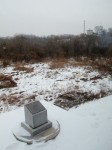 Next was a short drive to the checkpoint overlooking the Bridge of No Return. A couple decades ago, a detail from the UN side went to trim a tree obstructing the line of sight between the two checkpoints, and a gang of NK troops ran up and attacked them with axes, killing two of the UN troops and injuring several others. In retaliation, the UN launched the most expensive arborist detail in military history, deploying an entire battalion, an armored division, jets, and an aircraft carrier off the coast. The tree was completely removed, and now a memorial to the incident rests in its place.
Next was a short drive to the checkpoint overlooking the Bridge of No Return. A couple decades ago, a detail from the UN side went to trim a tree obstructing the line of sight between the two checkpoints, and a gang of NK troops ran up and attacked them with axes, killing two of the UN troops and injuring several others. In retaliation, the UN launched the most expensive arborist detail in military history, deploying an entire battalion, an armored division, jets, and an aircraft carrier off the coast. The tree was completely removed, and now a memorial to the incident rests in its place.
We drove right past the Bridge of No Return, where refugees were given the choice between the north and south. Once they crossed the bridge, they couldn’t change their minds, hence the name. We looped back to return to Camp Bonifas, and part ways with Cpl. Casiano.
The rest of the tour was behind the DMZ. Had I not just been to Panmunjeon, I would have been disappointed. The tunnel was just as you’d expect, a hole drilled in the ground, and Dorasan Station had a pretty lame view of the flag pole in Gijungdong, holding the largest flag in the world 160 meters above the ground. The only interesting thing at the train station was a platform headed to Pyongyang, with the promise of eventually connecting South Korea with Europe.
We took our last breaths of fresh air, and returned to Seoul in a blanket of snow, back to the calm unease of a country at war.
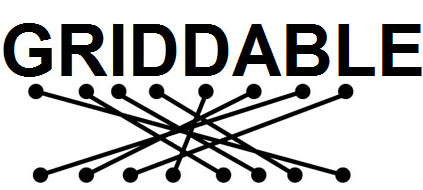
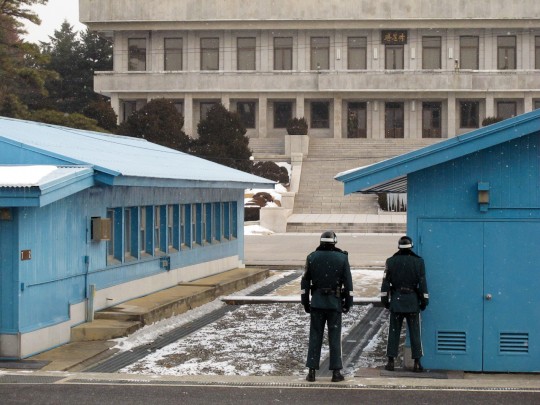


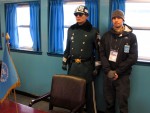

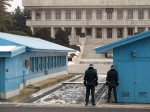

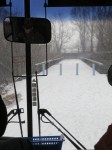

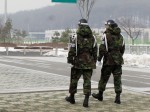
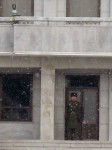
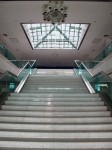
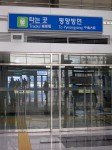


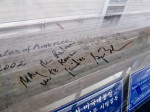








Leave a Reply